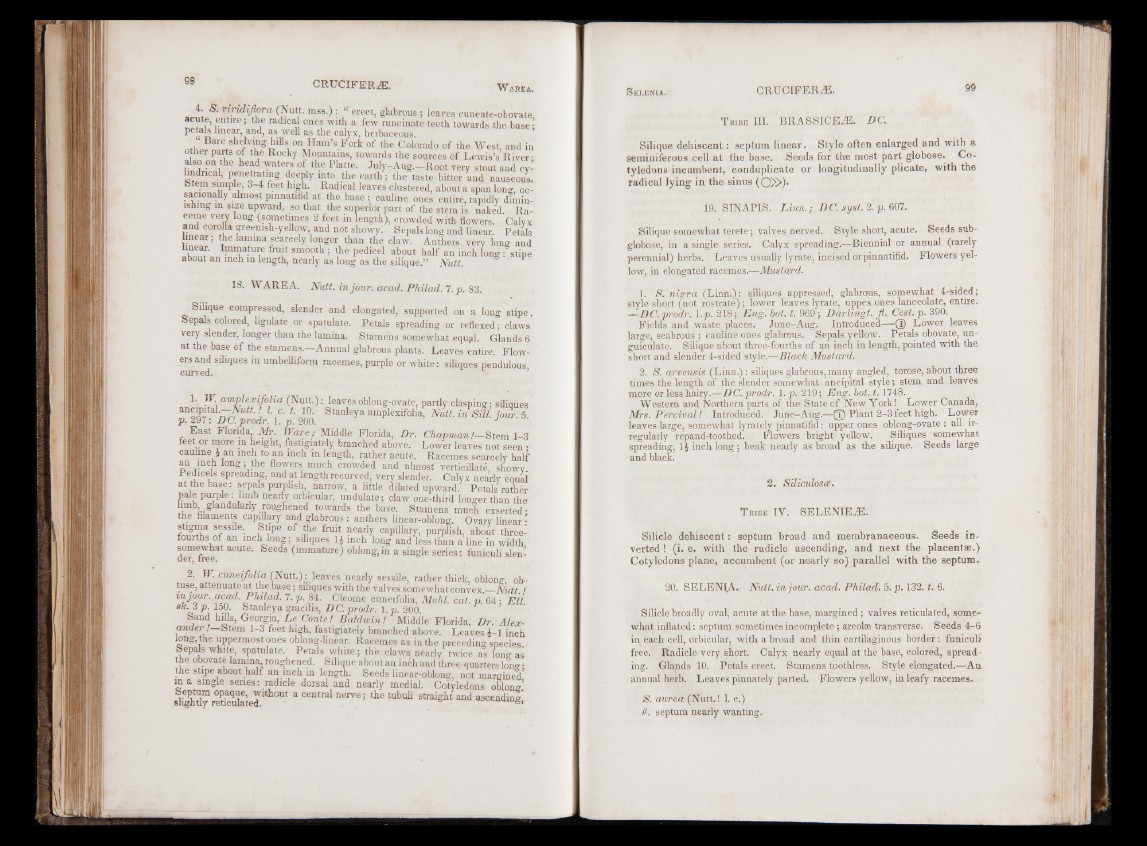
J : J : Vip difi?ra mss‘) ! “ erect,-glabrous ; leaves cuneate-obovate,
acute, entire; the radical ones with a few runcinate teeth towards the base •
petals linear, and, as well as the calyx, herbaceous. ’
Bare shelving hills on Ham’s Fork of the Colorado of the West, and in
other parts of the Rocky Mountains, towards the sources of Lewis’s River;
f i w i l — he^d tWat6!iS of, the Plat,te' July-Aug.—Root very stout and cy-
^ ’ Pf n 3, ? 8 t 6e?ly lato ,the earth; the taste bitter and. nauseous;
Stem simple, 3-4 feet high. Radical leaves clustered, about a span long, oc-
sacionally almost pinnatifid at the base; cauline ones entire, rapidly diminishing,
m size upward, so that the superior part of the stem is naked. Raceme
very long (sometimes 2 feet in length), crowded with flowers. Calyx
and corolla greemsh-y eflow and not showy. Sepals long and linear. Petals
lmear ; the lamina scarcely longer than the claw. Anthers very long and
hnear. Immature frrnt smooth ; the pedicel about half an inch long : stipe
about an mch in length, nearly as long as the silique.” Nutt. P
IS. WAREA. Nutt, in jour. acad. Philad. 7. p. 83.
Silique compressed, slender and elongated, supported on a long stipe.
Sepals colored, ligulate or spatulate. Petals spreading or reflexed; claws
very slender, longer than the lamina. Stamens somewhat equal. Glands 6
at the base of the stamens.—Annual glabrous plants. Leaves entire. Flowers
and siliques in umbelliform racemes, purple or white: siliques pendulous,
curved.
1. W amplexifolta (Nutt.): leaves oblong-ovate, partly clasping; siliques
l\ C- * onn* Stanleya amPlexifolia, p. 297: DC. prodr. 1. p. 200. Nutt. in S ill. j o u v l
East Florida Mr. Ware; Middle Florida, Dr. Chapman!—Stem 1-3
feet or more m height, fastigiately branched above. Lower leaves not seen -
cauline J an inch to an mch in length, rather acute. Racemes scarcely half
an inch long; the flowers much crowded and almost verticillate, showy
Pedicels spreading, and at length recurved, very slender. Calyx nearly equal
at the base; sepals purplish, narrow, a little dilated upward. Petals rather
pale purple: limb near y orbicular, undulate; claw one-third longer than the
lnnb glandularly roughened towards the base. Stamens much exserted;
the filaments capillary and glabrous : anthers linear-oblong. Ovary linear •
f lg“ a sessile. Stipe of the fruit nearly capillary, purplish, about three-
fourths of an inch long; siliques 1.4 inch long and less than a line in width
somewhat acute. Seeds (immature) oblong,in a single series; funiculi slen-
der, iree.
2. W. cuneifolia (Nutt.) :: leaves nearly sessile, rather thick, oblong, obtuse,
attenuate at the base; siliques with the valves somewhat convex.__Nutt '
xn jour.,acad. Philad. 7. p. 84. Cleome cuneifolia, Muhl. cat. p. 64; EU
sk. 3 p. 150. Stanleya gracilis, DC. prodr. 1. p. 200
Sand hills, Georgia, Le Conte! Baldwin! Middle Florida, Dr. Alexa
n d e r'—'Stem 1-3 feet high, fastigiately branched above. Leaves 4-1 inch
long the uppermost ones oblong-linear. Racemes as in the preceding species
Sepals white, spatulate. Petals white; the claws, nearly twice as king as
the obovate laminaroughened. Silique about an inch and three-quarters long;
the stipe about half an inch in length. Seeds linear-oblong, not margined
m a single senes: radicle dorsal and nearly medial. Cotyledons oblong’
^ghtty retkulated lth°Ut & central nerve> the tabuli straight and ascending’
T ribe III. BRASSICE^E. DC.
Silique dehiscent: septum linear. Style often enlarged and with a
seminiferous cell at the base. Seeds for the most part globose. Cotyledons
incumbent, conduplicate or longitudinally plicate, with the
radical lying in the sinus (0)£>)-
19. SIN APIS. L in n .; DC. syst. 2. p. 607.
Silique somewhat terete; valves nerved. Style short, acute. Seeds sub-
globose, in a single series. Calyx spreading.—Biennial or annual (rarely
perennial) herbs. Leaves usually lyrate, incised orpinnatifid. Flowers yellow,
in elongated racemes.—Mustard.
1. S. nigra (Linn.): siliques appressed, glabrous, somewhat 4-sided;
style short (not rostrate); lower leaves lyrate, uppes ones lanceolate, entire.
—DC. prodr. l.p. 218; Eng. hot. t. 969; Darlingt. Jl. Cest. p. 390.
Fields and waste places. June-Aug. Introduced— © Lower leaves
large, scabrous ; cauline ones glabrous. Sepals yellow. Petals obovate, un-
guiculate. Silique about three-fourths of an inch in length, pointed with the
short and slender 4-sided style.—Black Mustard.
2. S. arvensis (Linn.) : siliques glabrous, many angled, torose, about three
times the length of the slender somewhat ancipital style; stem and leaves
more or less hairy.—DC. prodr. 1. p. 219 ; Eng. hot. 1.1748.
Western and Northern parts of the State of New York! Lower Canada,
Mrs. Percival / Introduced. June-Aug.—© Plant 2-3 feet high. Lower
leaves large, somewhat lyrately pinnatifid: upper ones oblong-ovate ; all irregularly
repand-toothed. Flowers bright yellow. Siliques somewhat
spreading, 14 inch long ; beak nearly as broad as the silique. Seeds large
and black.
2. Siliculosce.
T ribe IV. SELENIE^E.
Silicle dehiscent: septum broad and membranaceous. Seeds inverted
! (i. e. with the radicle ascending, and next the placentae.)
Cotyledons plane, accumbent (or nearly so) parallel with the septum,
20. SELENIA. Nutt, in jour. acad. Philad. 5. p. 132. t. 6.
Silicle broadly oval, acute at the base, margined; valves reticulated, somewhat
inflated: septum sometimes incomplete (areolae transverse. Seeds 4-6
in each cell, orbicular, with a broad and thin cartilaginous border: funiculi
free. Radicle very short. Calyx nearly equal at the base, colored, spreading.
Glands 10. Petals erect. Stamens toothless. Style elongated.—An
annual herb. Leaves pinnately parted. Flowers yellow, in leafy racemes.
S. aurea (Nutt.! 1.c.)
0. septum nearly wanting.